
鯛よし百番
Taiyoshihyakuban ◆ たいよしひゃくばん
3.39
Nishinari-ku
「Japanese Cuisine」
6,000-7,999円
4,000-4,999円
Opening hours: (Lunch) 13:00-16:00 (Dinner) 17:00-22:00 Please make reservations in advance.
Rest time: Monday
大阪府大阪市西成区山王3-5-25
Photos
(20)



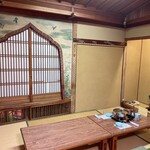













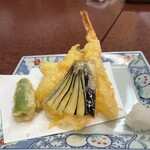


Details
Reservation Info
(on) a subscription basis
Payment Method
Credit cards accepted
(VISA, Master, JCB, AMEX, Diners)
Electronic money is not accepted
QR code payment accepted
(QR code payment is accepted (PayPay)
Restaurant Service Fee
No room and service charge
This fee is charged by the restaurant, not related to our platform
Number of Seats
100 seats
Private Dining Rooms
Yes
All rooms are private rooms. We have large and small rooms that can accommodate 2 to 28 people. Table seating is also available.
Smoking and Non-Smoking
No smoking on the 2nd floor.
Parking
None
Coin-operated parking available nearby
Facilities
There is a tatami room
Comments
(21)
miots427
4.30
Located in Tobita Shinchi, a place that was originally a red-light district and is now registered as a tangible cultural heritage site. The exterior and interior exude a sense of history, making it enjoyable just to walk around. However, as two women in their 20s, we definitely felt out of place. (Apparently, there are quite a few female customers as well, mostly in their 30s to 50s.) Surprisingly, despite being a weekday night, there were few customers both outside and inside during prime time. We were guided to a private room on the second floor after taking off our shoes in the spacious entrance. All the seating was in private rooms, providing a comfortable and spacious atmosphere. You can call the staff using a phone in each room as needed, and there was also air conditioning in each room, making it very comfortable.
- Tai-chiri Course ¥5,500
The appetizers were plentiful, but the main hotpot ingredients were surprisingly abundant for two people. The sashimi of sea bream had a rubbery texture and wasn't very tasty, but the sea bream in the hotpot was delicious. According to my friend, the eggplant gratin was the most delicious... (laughs) I noticed that there were occasionally scales left on the sea bream in the hotpot, and the serving plate was sticky. As for the sea bream shabu-shabu, it was best to eat it quickly after the brief cooking time when the fish was just barely cooked. Overall, the ambiance and taste were good, and I think it's a restaurant worth visiting at least once. Just a heads up for the ladies, there are few women's restrooms! Thank you for the meal ★
--- Course Content ---
Appetizers (Tuna, Sea Bream)
Eggplant Gratin
Tai-chiri Hotpot
Udon noodles to finish
Dessert (Watermelon, Pione grape)




えいじ@
3.80
In the old red-light district built in the 7th year of Taisho era, the registered tangible cultural property "Taiyoshi Hyakuban" held a photo shoot event (*^◯^*). With TikTok's monetization now starting in Japan, making money through views has become the norm. Even mediocre online streamers can now proudly claim it as a job and deduct expenses when declaring taxes. Despite not wanting to chat with young girls, I had to endure the lively photo shoot event and after-party, all while pretending to enjoy it. As someone who loves photography and my job, I persevered through the discomfort and remained professional (lol). #NishinariAeruTown # TobitaShinchi #oldredlightdistrict #TaiyoshiHyakuban #registeredtangibleculturalproperty #TaishoRomance #TaishoEra #modelphotoshoot #nowrecruitingmodels

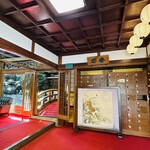


イブオっち
4.50
The drinking party on this day was held at "Taiyoshi Hyakuban" in Nishinari-ku. It was a support party for a restaurant that is still operating despite the pandemic. The organizer reserved an izakaya called "Taiyoshi Hyakuban" in Nishinari-ku Yamao. This "Taiyoshi Hyakuban" is an izakaya located in a former "pleasure quarter" building that became famous even in Demon Slayer. It seems that they recently renovated it beautifully using crowdfunding. Now, the dishes included appetizers, sashimi, simmered dish, grilled ayu fish, tempura, tekka maki, green tea soba, and finally fruits. We started with beer and then switched to shochu. The food and drinks at Taiyoshi Hyakuban, in a former pleasure quarter, were quite exquisite and all tasted amazing~~~




kota398740
3.00
I visited Hyakuban in Tobita Shinchi for the first time. I was amazed by the beautiful women inviting me, and finally arrived. The building has a charming atmosphere that is quite soothing. I chose the kaiseki course for ¥5,500 instead of a hot pot. With beer and sake, the total bill was just under ¥7,000. The taste and portion were both excellent, and the invited guests were satisfied.




おいしいもの色々
3.00
I had always wanted to visit this restaurant because the building itself is a historic structure from the Taisho era, but the location is quite out of the way. Although the food and service were nothing special, the building was truly magnificent.

adfp2he
3.20
I have always wanted to visit this restaurant. It used to be a red-light district apparently. It is designated as a registered tangible cultural property, so it feels quite luxurious and elegant. While the sukiyaki and hot pot dishes are famous, we opted for a course menu. I went with a group for a social event, so the main focus was on drinking and socializing rather than eating slowly. The amount of food was just right, and the sashimi was delicious. We had plenty to talk about and the atmosphere was great. It was enjoyable to step outside and experience the unique ambiance!




ぶりぶり♡めぐみ
4.20
This is a building that was built as a brothel from the end of the Taisho era to the beginning of the Showa era. It is a registered tangible cultural property where you can see it as it was at that time, now serving as a restaurant. The exterior as well as the interior are wonderful. You can admire the meticulous tatami-covered corridors, intricate sliding door paintings, luxurious transoms, and elaborate decorations that gather the essence of Taisho architectural art. It feels like dining in an art museum. It may be difficult to find, so taking a taxi is recommended. Reservations are required. I reserved a four-person portion of chanko-nabe. There were more ingredients than I imagined, and the luxurious miso chanko soup was delicious. I wanted to have zosui (rice porridge) at the end, but I was too full. I was very satisfied with both the building and the meal. It was delicious. Thank you for the meal. I want to go again.




投資有価証券
4.00
The food is quite ordinary, but considering the atmosphere and the location, the price is not high at all. If you enter a cheaper restaurant, you can start a journey back in time and experience something out of the ordinary. It is registered as a tangible cultural heritage, and I hope it will be preserved as a historical heritage of Japan for a long time. The place seems quite worn out upon closer inspection, even though it was supposed to have been renovated through crowdfunding. It seems like the maintenance is not being done properly, which is concerning for its future.




sara_a
3.50
Lunch at a hot pot restaurant. I went to Taiyoshi Hyakuban, which has a very nice interior. It's a reservation-only restaurant, and they call to confirm the reservation the day before. The menu is chanko-nabe, a miso-based hot pot with a sweet flavor. It's filled with a variety of ingredients like meat, fish, and vegetables. You can enjoy it in your own style without much service.
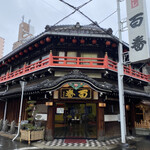

yazuy902
3.00
I put the sea bream bones in myself, made the broth, and got a lot of sea bream! Delicious. The building was amazing! Great service, they let me see other rooms in the building after finishing my meal. They even explained everything to me, it was the best service.


kira.kira
3.50
Taishi Yoshii Hyakuban Tai Chiri Course 5500 yen, drinks not included. Shinkamiya, Osaka. I had always wanted to visit this historical building from the Taisho era for a meal. From the lanterns at the entrance to the interior, it was a series of surprises. The photos are amazing. The food was delicious. The building and the interior space are incredible. Originally used as a red-light district, the craftsmen's work from the time is evident in the fantastic interior, from the walls to the ceiling. The staff were kind and explained the historical background in detail despite being busy. Thank you very much. Located in a corner of Tobita Shinchi's red-light district, I wouldn't recommend going alone as a woman.




デパ地下のまおさん
3.50
First visit after reopening! I heard that they have started serving lunch during lunchtime, so I tried their chanko-nabe for 3500 yen! The system is almost the same as at night, with reservations required and the menu unchanged. It seems like the individual menu items that were available before are now gone, except for drinks. Maybe it's because it's lunchtime...? I was looking forward to seeing the indoor renovations after the refurbishment, but it seems like there were both good and disappointing aspects, almost at opposite ends of the spectrum. Some places seemed like it would have been better to leave them in their run-down state rather than trying to repair them. However, the landlady was friendly and the hot pot was delicious, so it's all good! I heard that they are experimenting with different flavors, so even if you've been there before, I recommend going back for another visit.




izupon24
3.50
Tonight, I had a hot pot at Taioyoshi Hyakuban, a former brothel in Tobita Shinchi that has been turned into a restaurant. The name "Hyakuban" is said to be the highest rank for brothels. The building is impressive and I hope they continue to maintain it. Honestly, I didn't have high expectations for the food, but the broth was surprisingly delicious. The Hyakuban hot pot costs 4500 yen. Thank you for the meal. I will definitely come back.

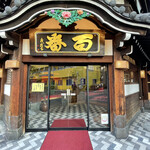


tom0218
4.00
Today, I attended a hot pot event at a fascinating place. This place is the heart of a region that brings tears of joy to gentlemen. I made a reservation for a course to experience tangible cultural assets firsthand. I have been wanting to visit this place for a long time to confirm the atmosphere and to help raise repair funds to preserve the culture. I arrived at 5:00 pm to explore the surroundings before my 6:00 pm reservation. The exterior is majestic and charming. As I entered, I saw a bridge that separates the real world from paradise, and a contemplation bridge in the pleasure quarters, adding to the historical and fascinating atmosphere. There are various items that make you feel the history and it's a place that is not easily visited due to its nature, but I highly recommend that you visit this famous place. I was seated on the second floor and started with a toast with a glass of beer. The presentation of the appetizer, firefly squid with vinegar miso and assorted sashimi, was beautiful. I enjoyed them with a bottle of shochu mixed with water. And now, the main event has arrived. The hot pot. Although they now use gas canisters, the room still has remnants of gas pipes, with 6 outlets, reminding me of the past when hot pots were cooked over gas pipes. The hot pot was filled with plenty of ingredients and I enjoyed it before settling the bill. After that, it was time for adult activities. Suddenly, I received a call on my phone. A senior colleague was in Namba, so I headed there by taxi to continue the evening. Thank you for the wonderful meal.



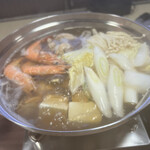
ahoyarou
3.80
It's about a 15-minute walk from Tsutenkaku. After passing through a unique shopping street with only karaoke pubs, and walking past the women of Tobita Shinchi, you'll arrive at the edge of the area. When making a reservation, they ask for at least two phone numbers and what type of hot pot you want. I ordered curry hot pot. It was my second stop, so I didn't think I could eat much, but surprisingly it was quite delicious and I ended up eating a lot. Udon also comes with it. The building has a charming style with a courtyard that reminds me of the movie "Sakuran", with beautiful glass windows and wooden craftsmanship that is very exciting and cannot be replicated. It's old so it's understandable, but even though there is air conditioning, the windows don't completely close, so it can be a bit cold in winter. The hot pot is delicious haha. I hope this beautiful building will be cherished for a long time, and it made me reconsider my values, both for people and the city.




にじいろさん
3.50
Visit date and time: 6:00 PM on a weekday
Waiting time: Reserved visit
Menu: Kaiseki cuisine
I had been wanting to visit this place for a while, and finally had the opportunity to do so. This time, I visited with colleagues for a year-end party. The taste of the food was decent, but being able to dine in a historical building added extra value beyond the price. We dined on the first floor, but after checking with the staff, we were able to take a tour of the entire building including the second floor. The building has a lot of history but is also showing signs of aging, and I heard that there are plans for crowdfunding for its restoration next year. Thank you for the meal.




kinako-anko
3.80
On October 9, 2021, the second part of the entertainment tour for my friend in Tokyo took us to Koka City, Shiga Prefecture, where we enjoyed "matsutake mushroom hunting" and all-you-can-eat "sukiyaki with Omi beef and matsutake mushrooms." We returned to Osaka at 4 pm and dropped off my friend at the hotel. But it didn't end there; we continued with part three. Three of us got off at Abeno Station on the Osaka Metro Tanimachi Line around 6 pm and walked 800m west to reach a ryotei (traditional Japanese restaurant) called "Taiyoshi Hyakuban" in Tobita Shinchi, Nishinari Ward. The two-story wooden building lined with red lanterns is a historical structure registered as a tangible cultural property of Japan. The name "Hyakuban" signifies the highest rank in the red-light district, and the building, resembling the Yomeimon Gate of Nikko Toshogu Shrine, features a sleeping cat at the entrance of the reception room and flamboyant Momoyama-style decorations, preserving the lively atmosphere of Osaka's entertainment district. From December, the Fuji TV series "Demon Slayer: Entertainment District Arc" will be aired, and the ambiance reminded us of that, making us feel excited.
We were led to a spacious tatami room on the second floor and enjoyed a draft beer for 530 yen, a set menu with appetizers and sashimi for 1000 yen, and a pot dish (bonito broth) for 3000 yen per person, including chicken, pork, shrimp, scallops, clams, grilled conger eel, white fish, salmon, and vegetables. We started with a toast with beer and enjoyed the appetizers, but the sashimi, consisting of sea bream and tuna, seemed not very fresh, so I left it to my friend who enjoys raw fish. The pot dish began with me putting the seafood and meat from two large plates into the bonito broth pot. However, after the all-you-can-eat sukiyaki with Omi beef and matsutake mushrooms for lunch, we couldn't eat much more by evening, so we had to leave some food unconsumed. After an hour, we left the restaurant and walked back the same way, heading north for 1.5 km, passing through Tobita Shinchi, Tobita Hondori Shopping Street, Janjan Yokocho, and Tsutenkaku Hondori Shopping Street, before heading back home on the Sakaisuji Line from Ebisucho Station. The area still retains the atmosphere of Osaka's past, and "Tobita Shinchi" is Japan's largest red-light district built in the Taisho era. Although it became a ryotei district after the enforcement of the Anti-Prostitution Law in 1958 under the name "Tobita Ryotei Association," the establishments still maintain the appearance of brothels with young women sitting at brightly lit "decoration windows" and older women luring customers, just like in the past. Many establishments, although labeled as ryotei, continue to operate as before 1958, evading the law by turning into ryotei and engaging in free romantic relationships between customers and waitresses. It was shocking to see such a place that seemed like a time slip into the digital age. The adjacent streets, Zoo Mae Ichiban Street and Niban Street, are lined with small izakayas, karaoke bars, and pubs in the "Tobita Hondori Shopping Street" arcade, where homeless people lie on cardboard, and intoxicated men and women in flashy outfits stagger around, creating a lawless area. The vicinity around Tsutenkaku Tower is well-maintained to cater to inbound tourists, but further south, passing under the elevated tracks of the JR Loop Line and crossing the main street, requires courage to explore. This review turned out to be more exciting, and perhaps it was suitable for the 4800 commemoration (laughs). Thank you for the meal! (●^o^●)




eb2002621
3.90
I visited a restaurant that used to be a brothel in the Taisho era, located in Tobita Shinchi. It is now being used as a traditional Japanese restaurant, with a luxurious atmosphere. I made a reservation for a private room on the second floor and enjoyed a hotpot meal with various ingredients such as chicken, pork, shrimp, scallops, clams, grilled conger eel, white fish (sea bream), salmon, vegetables, tofu, and yuba. The set menu included salmon marinated in vinegar and sashimi. The food was better than expected, and the unique atmosphere of the restaurant added to the overall experience. It was a delightful dining experience!




mieっち
5.00
I used it for a gathering with friends! The miso-based hot pot was delicious! The photo is for three servings and we were very satisfied. The sesame tofu appetizer and the udon noodles at the end were also delicious, although there are no photos. The restroom on the first floor is good for men because multiple people can enter at once, but for women, there is only one private room even though the space is large, so only one person can enter at a time, causing a line to form towards the end. Female customers should be aware ⚠️




massz
4.00
Located in the red-light district of Tobita Shinchi, near Shin-Imamiya Station, this restaurant is not easily accessible for women dining alone. The establishment used to be a large brothel, and you can still see remnants of its past in the atmosphere. Reservations are required to dine inside, but the ambiance of the restaurant is truly remarkable. The interior feels like a time warp, offering a unique and captivating experience. The food, while not exceptional, is decent hot pot cuisine that I enjoyed.


Mikutama
3.60
This is a review from a New Year's party. I visited for the first time in 4 years. Nowadays, Nishinari and Tobita Shinchi are representative tourist spots in Osaka. I am impressed by the fact that they can gather such cute girls. Located in such a place, Taioyoshi Hyakuban is a historic shop designated as a tangible cultural property of the country. If approached from the south side, you can reach it without passing through Shinchi, so there are many female customers as well. The appearance reminiscent of Jiufen in Taiwan is magnificent. The interior, with features such as the Omoi and Yomeimon gates, conveys the history and luxury of its former use as a pleasure quarter. The cuisine is just a simple dashi hot pot. There aren't many restaurants these days that serve such a pot. It is delicious in its own way, but the true value of this restaurant lies in its building. Since each room has a different atmosphere, the satisfaction level may vary depending on the room you are guided to. If you visit, I recommend taking a look inside the building. Also, I felt the changing times when the servers who attended to us were young people from Sri Lanka. Thank you for the meal!




Email Login